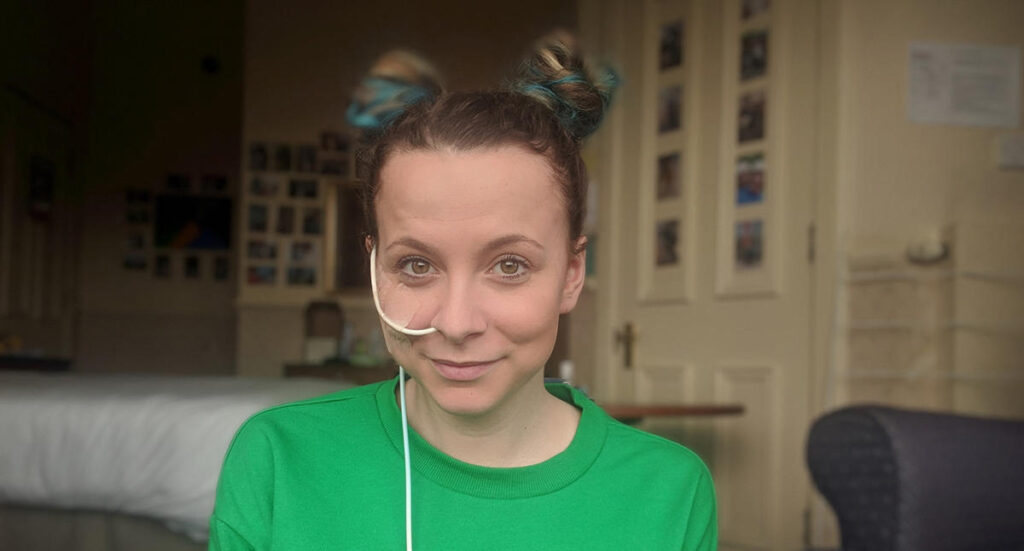Eating disorder sufferer Faye Bingham says as a teenager sometimes it took six members of hospital staff to insert her feeding tube. (Image supplied)
Faye Bingham was only 13 when her eating disorder first saw her admitted to a psychiatric hospital. Depressed and refusing to eat, her weight had plummeted to a dangerously low level and doctors said she needed intensive treatment.
“I was really underweight and malnourished and had so little energy that I felt like a zombie,” says Bingham, now 26 who lives with husband Andy, 31, a design engineer in Kidderminster.
“I needed to be fed by a nasogastric tube – a tube down my nose. But I was scared and sometimes it would take six members of staff to hold me down while they inserted it. At first, it really hurt and it rubbed against my nose. I didn’t like it at all but at least it meant that my weight increased and slowly I began to feel better.”
Now aged 26, Bingham says eventually her feeding tube became part of everyday life. (Image supplied)
Doctors diagnosed Faye with the eating disorder anorexia nervosa and for nearly a decade she was in and out of hospital for more nasogastric tube feeding and counselling.
But in fact, the doctors were wrong. What Faye did have was a condition that has only recently been recognised – Avoidant Restrictive Food Intake Disorder (ARFID), previously referred to as ‘Selective Eating Disorder’.
According to the eating disorder charity BEAT, ARFID is different from anorexia and other related conditions because negative beliefs about weight and body shape are not the reason why people stop eating.
Read more: Signs your child has an eating disorder and how to help them
Instead, the condition stems from a variety of factors – fears of choking or vomiting or the person will only eat certain textures of food. This was certainly the case for Faye, who is also autistic, a known risk factor for ARFID.
“When I was growing up, I was always a fussy eater and would only ever eat things that were hard, crisp or beige,” she says. “By the age of 13, I’d stopped eating completely. I couldn’t bring myself to put food near my mouth and even now, foods like porridge or rice pudding make me feel strange.
“At the time, I couldn’t explain how I felt and even now it’s difficult to describe. I really struggle with the sensory elements to food such as the texture or smell. It’s like there’s a brick wall between me and the food.”
It is essential Bingham has the feeding tube to make sure she gets all the nutrients she needs.
Her first admission to a psychiatric hospital as a young teen lasted for a year and Bingham was treated alongside children who had anorexia. But she always felt that she was different.
“In body image sessions I’d hear other girls talking about how they hated their bodies and I didn’t feel that way at all but I didn’t say anything,” she says. “All the professionals were telling me that it was anorexia so I went along with it. I didn’t know what to believe.”
Read more: Calories must now be labelled on menus: Anorexia sufferer says this is dangerous
In fact, it was only when she was 21 and was admitted to the Glasgow Eating Disorder Clinic that she was finally given the correct diagnosis. “I’d been in and out of treatment for years but this one doctor seemed to really listen to what I was saying and diagnosed me with ARFID,” she says.
“It’s been a real relief. Suddenly everything seemed to fit into place and it’s been easier to articulate how I’m feeling.”
Bingham’s eating disorder is known as Avoidant Restrictive Food Intake Disorder (ARFID), previously called ‘Selective Eating Disorder’.
Yet despite the diagnosis, Faye continues to lives 24/7 with a nasal feeding tube that provides all the nourishment she needs. Although she is able to physically eat some foods such as chips, chocolate and the ‘beige food’ she could eat as a youngster, it will never be enough to provide all the nutrients she needs.
“I know I’ll need the tube for life and I’ve come to accept that recently,” she says. “I can still do what everyone else can do, even swimming, but you do get some very funny looks and I can feel self-conscious.”
Read more: Eating disorder battles: 8 celebrities who have spoken out
But her illness has led her to launch a business called Tubie Life to help the thousands of people who need nasogastric feeding tubes, whether for eating disorders or other illnesses such as cancer.
“The idea came to me when I was in hospital three years ago and wanted to go to the café with visitors but only had a big IV pole to hang my feeding bag on,” she says. “I had a backpack so I sewed a hoop into it and took my bag of food and my drip down in that.
“I decided to make a prettier version and when my husband saw it, he suggested that other people would like them and that I should go into business. So that’s what I’ve done. I’ve got a range of designs of fashionable everyday backpacks but they have space for feeding bags and pumps as well as space for normal things like laptops and sports gear.
“The reaction has been fantastic. I love it when people post their bags on Instagram and give me good reviews. Living with a tube like this is not easy but I like to think I’ve made the world more accessible for people like me.”
For support visit Beat, the UK’s leading eating disorders charity.
Watch: Sophie Turner had a live-in therapist to help with eating disorder

